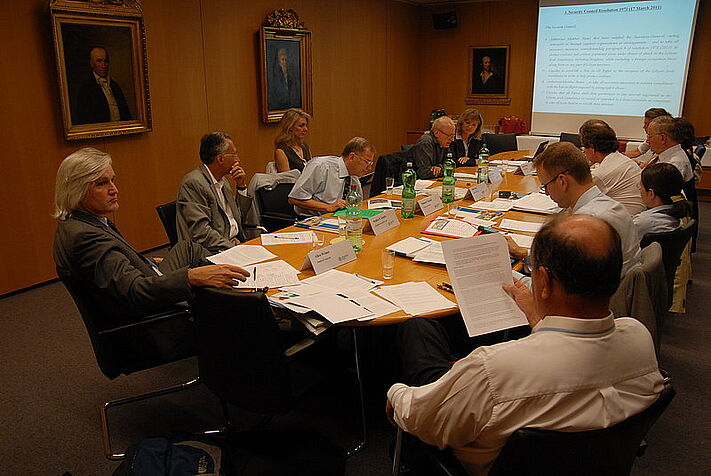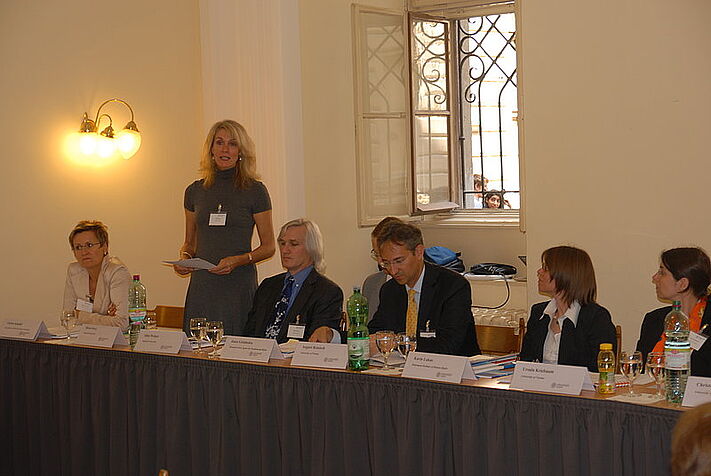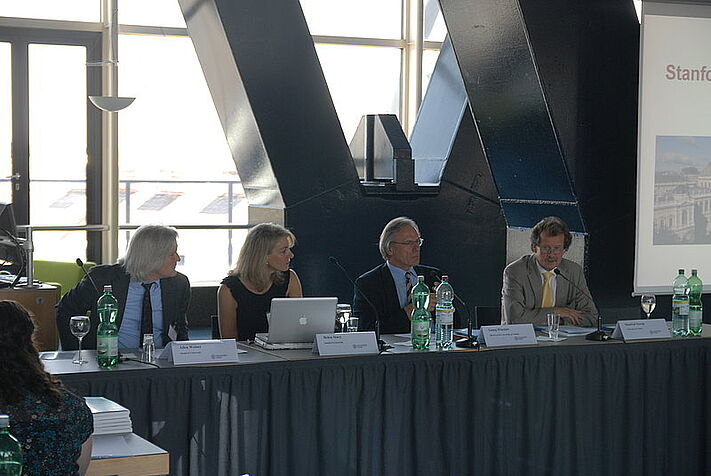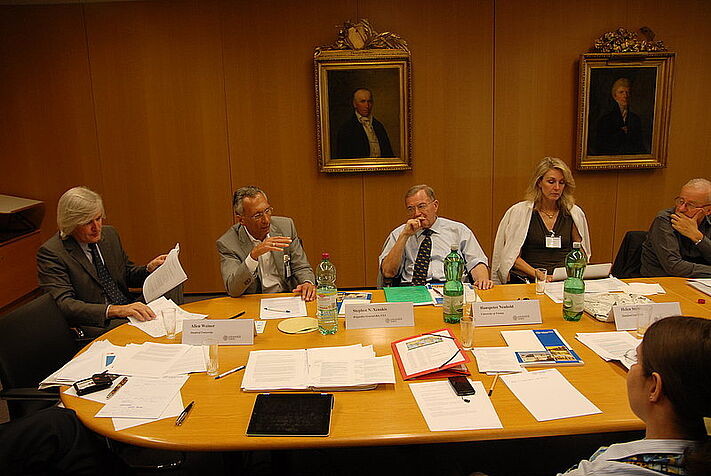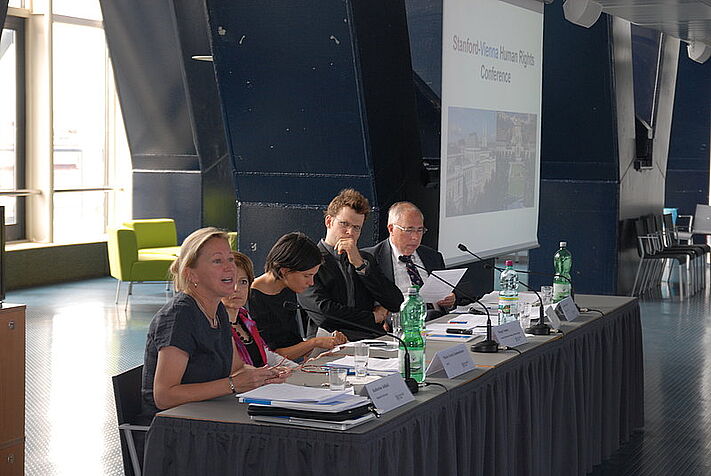Stanford - Vienna - Human Rights Konferenz "US-American and European Approaches to Contemporary Human Rights Problems"
In the framework of the cooperation between the University of Vienna and Stanford University regular bilateral conferences take place. In 2004, Prof. Norman Naimark’s research project “Austria in the Postwar World” led to the first conference, followed by further conferences in 2006 and 2009. This year’s Stanford-Vienna Conference brought together human rights experts to discuss US-American and European approaches to contemporary human rights problems. The conference took place from 20 to 22 June 2011 at the University of Vienna and was organized by the Section for International Law and International Relations of the Law School in cooperation with the Boltzmann Institute of Human Rights and the Research Platform “Human Rights in the European Context”.
After welcome remarks by Christa Schnabl, Manfred Nowak and Helen Stacy, the Chair of the first session, August Reinisch, opened the first panel of the Conference, “Monitoring, Protection and Enforcement of Human Rights in Comparison – US & Europe”. The first speaker, Manfred Nowak, addressed the development and current state of European human rights mechanisms. After outlining each system in more detail, Prof. Nowak pointed out the major challenges to human rights protection in contemporary Europe and especially emphasized problems relating to the way Europe deals with non-Europeans. After this overview, Christoph Grabenwarter proceeded with a detailed account of the historical development of the procedures before the European Court of Human Rights and the legal force of its judgments. He assessed the background of the coming into existence as well as the benefits and downsides of the pilot judgment procedure and pointed out the practical problems resulting from the huge workload of the European Court of Human Rights and suggested possible solutions to it. Ursula Kriebaum continued with an introduction to the systems and principles of the European Committee for the Prevention of Torture and Inhuman or Degrading Treatment or Punishment (CPT). As a major shortcoming, she identified the fact that the CPT has no coercive means to make states comply with its recommendations, the “most intrusive” tool being its “public statements”. Karin Lukas, introducing the European Committee of Social Rights, gave an account of the development of the European Social Charter (ESC) and its state of play. She pointed out the unique features of the ESC and concluded that even though there is a continuous issue of non-compliance, there have been a lot of substantive changes due to the Charter and outlined the importance of ongoing dialogue. Jonas Grimheden then proceeded with outlining the changes that came about with the entry into force of the Treaty of Lisbon. In his concluding remarks, he elaborated on the nature and effectiveness of the EU Agency for Fundamental Rights (FRA). With Allen Weiner, the focus moved from Europe towards the US. He started off with an outline of the limited participation of the US with regard to International Conventions dealing with human rights and made the audience familiar with explanations for this approach. Whereas Allen Weiner talked about the external dimension, how the US views itself in comparison with Europe, Helen Stacy focused on the internal debates within the US. She pointed out the ubiquitous use of rights-language within the US and related it to the realities by giving examples, like the health care system, the death penalty or the right to hold handguns. She argued that there were basically two framing understandings of human rights in the US; being the Constitution and the political discourse on individualism. James Cavallaro proceeded with an account of the capacities and the potential of the OAS, relating it to European systems of human rights protection. He analyzed in more detail the peculiar relationship between the Inter-American Commission of Human Rights and the US. Influence, according to him, comes about insofar as media pressure, civil society and grass root pressure, referring to findings of the Inter-American Commission, can exert political leverage.
The first session was followed by a Public Lecture, entitled “US v. Europe – Human Rights Standards, Mechanisms and Policies”. After opening remarks by the Chairs, Ursula Kriebaum and Allen Weiner, Manfred Nowak talked about the roots of domestic human rights protection in the US and Europe and their role in the founding of international and regional human rights protection. He drew the conclusions that in domestic human rights protection, Europe has taken the lead since WWII, while the US is more reluctant to be monitored. However, in foreign policy, the US as a “global player” is more effective. Helen Stacy confirmed the conclusions of Manfred Nowak. She emphasized dualism in the US and the fact that whereas the US certainly has a lot of human rights jurisprudence, this relates to civil rights within the US rather than to international human rights law. Friedl Weiss then sketched the human rights architecture of the EU. He elaborated on the implications of the entry into force of the EU-Charter of Fundamental Rights but came to the conclusion that it was not a paradigm change. He also outlined that access to justice at the EU level was only indirectly possible, a fact that would be improved through accession to the European Convention on Human Rights (ECHR). James Cavallaro reaffirmed the reliance of the US jurisprudence on domestic civil rights instead of international human rights. He pointed out the downsides of it; especially that the US Constitution does not contain economic, social and cultural rights and that there can be different interpretations of for example what amounts to torture.
Helen Stacy opened the Tuesday session on “Responsibility to Protect – The Case of Libya 2011” with a short account of the historical development of the Responsibility to Protect (R2P). Irmgard Marboe started off with an evaluation of the still controversial legal nature of the R2P. She gave a detailed assessment of Articles 138 and 139 of the World Summit Outcome Document of 2005 and their legal implications. Prof. Marboe subsequently elaborated on the legal nature of the veto, whether it was capable of being abused or not and what the implications of an abuse could be. Hanspeter Neuhold analyzed in detail SC Resolution 1973 of 17 March 2011. He concluded that in the case of Libya, arguably, the SC lived up to its R2P even though until now the actions have not been successful. Referring to the situations in other countries like Syria and Saudi Arabia, he made the point that unfortunately Realpolitik prevails over more noble goals. Heinz Gärtner proceeded with an elaboration on the report “The Responsibility To Protect” of the International Commission on Intervention and State Sovereignty of December 2001 and the concept of “just war”. He applied the different criteria to the current situation in Libya and concluded that it could be argued that the Libyan case was a R2P case even though the Resolution refers to the UN Charter and the threat to international peace and security. Allen Weiner elaborated on the US position with regard to the intervention in Kosovo, arguing that the US did not consider it legal but rather justified, pointing to the legitimacy, however, not to legality. He concluded that the R2P is no independent, legal basis to act but much more a political exhortation. He related this finding to the arguments brought forward by the US for the use of force in Libya. Stephen Xenakis proceeded with an assessment of the R2P from the more practical perspective of a military physician. He argued that also humanitarian intervention without the use of force but rather with deploying health service personnel could be envisaged.The afternoon panel on “Corporate Social Responsibility / Human Rights and Business” was opened by Friedl Weiss with introductory remarks. David Brady introduced Friedman’s conception of responsibility of business. He pointed out the problems of Corporate Social Responsibility (CSR) and mapped three types of motives to CSR, being strategic, defensive self-interest or principled. He presented an analysis of the different approaches towards and motives behind CSR on the part of companies. Karin Lukas proceeded with human rights and business in the European Union. By analyzing the Commission’s documents on CSR and the role of the European Parliament as an antagonistic player, she sketched the different tracks of the voluntary and regulatory approach that could be pursued. After giving a short introduction to Export Processing Zones (EPZs) and outlining their positive as well as negative effects, Christina Binder focused on the challenges to implementing human rights in EPZs. Her assessment of the impact of different strategies to foster the implementation and enforcement of human rights and labor standards in EPZs led her to the conclusion that there have been improvements with regard to rights in EPZs but she also emphasized the insufficiency of the focus on the responsibility and accountability of the host states to improve working conditions in EPZs.
On the last day of the Stanford-Vienna Conference, 22 June 2011, the participants dealt with “Asylum, Immigration and Human Trafficking”. The session was opened by Gerhard Hafner. He gave the floor to the first speaker Margit Ammer, who introduced the development of the competences of the EU in the area of asylum and immigration. She outlined the major human rights challenges. Joachim Stern took over with his presentation on EU policies and perspectives on migration and human rights after Lisbon. He concluded that the effects of the new framework included minor improvements but, however, also substantial drawbacks. With Maria Grazia Giammarinaro, the focus shifted from EU immigration and asylum law and policy to human trafficking. She outlined the factual situation of trafficked human beings and the striking easiness with which a crime like that can be committed. The social vulnerability of migrants often makes them subject to human trafficking, which links the phenomenon of migration and human trafficking. Further policy areas that would have to be included would be the labor market as well as the responsibility of businesses with regard to human rights. Katherine Jolluck dealt with trafficking of women and girls in Eastern Europe for sexual exploitation. She focused on the Council of Europe Convention on Action against Trafficking in Human Beings of 2005 and argued that it followed a human rights based approach. She sketched the actions taken by Eastern European countries, which led her to the conclusion that even though considerable progress has been made in Eastern Europe with regard to the understanding of human trafficking and best practices, the commitment however, needed to run deeper in the governments and societies in order to achieve real progress.
During the closing session, the outcomes of the Conference were summarized and the different approaches compared. In her final comparison, Helen Stacy concluded that Europe is the envy of the US when it comes to the existing institutionalized human rights framework. She analyzed that to a certain extent, Europeans have recognized that national sovereignty has become a secondary interest and Europe has become a collective primary interest. In the US, human rights are much more a political matter and are not so much present in the legislative discourse. How human rights are implemented is a question of politics. Her final conclusion was that many roads lead to Rome. She sees that law is only one of the options, which works with civil society, individuals and global capital. The European systematic regulatory path is not the American way. Manfred Nowak observed that the major differences are in foreign policy where the US takes a leading role and Europe has a problem to speak with one voice. Further differences relate to the manner how human trafficking is dealt with. Whereas in Europe it is at least to some extent framed by a human rights discourse, in the US, it is approached from the criminal law aspects.
Allen Weiner concluded the theoretical discourse by applying it to six hypothetical individuals and analyzing how the different approaches in the US and in Europe and the supposedly “better” human rights system in Europe would affect their particular situations: The middle class student, the blue-collar worker, the female corporate executive, the illegal immigrant from Algeria, the lawful immigrant from Ghana and the chronically ill person. Manfred Nowak concluded that on average, most of them would be better off in Europe, however, the immigrant would most probably have better chances to climb the career ladder in the US than anywhere in Europe. Helen Stacy confirmed this by relating it to the background to US human rights approaches and observing that in the US the great leap is easier no matter who you are, which encourages individuals to be exceptional. The successful conference was formally closed by the University of Vienna’s rector Georg Winckler.

